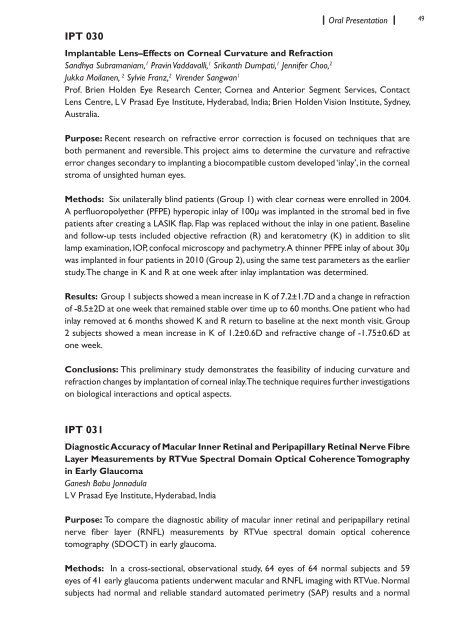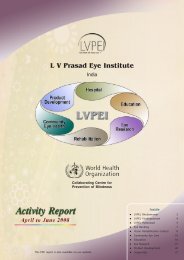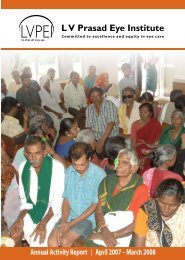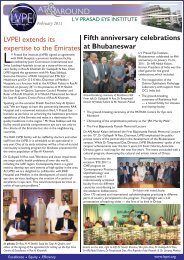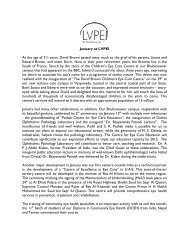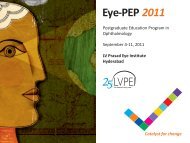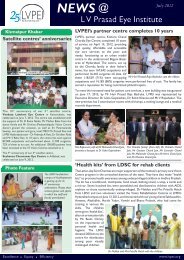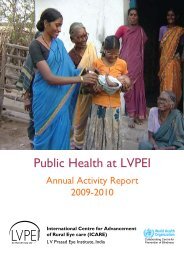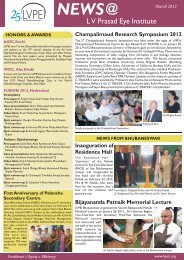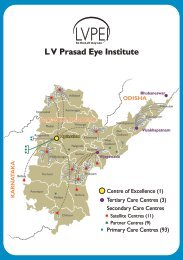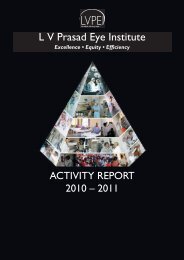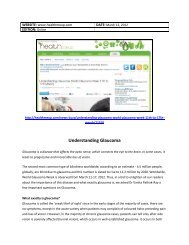IERG Abstracrt Book.indd - LV Prasad Eye Institute
IERG Abstracrt Book.indd - LV Prasad Eye Institute
IERG Abstracrt Book.indd - LV Prasad Eye Institute
You also want an ePaper? Increase the reach of your titles
YUMPU automatically turns print PDFs into web optimized ePapers that Google loves.
IPT 030Oral Presentation49Implantable Lens–Effects on Corneal Curvature and RefractionSandhya Subramaniam, 1 Pravin Vaddavalli, 1 Srikanth Dumpati, 1 Jennifer Choo, 2Jukka Moilanen, 2 Sylvie Franz, 2 Virender Sangwan 1Prof. Brien Holden <strong>Eye</strong> Research Center, Cornea and Anterior Segment Services, ContactLens Centre, L V <strong>Prasad</strong> <strong>Eye</strong> <strong>Institute</strong>, Hyderabad, India; Brien Holden Vision <strong>Institute</strong>, Sydney,Australia.Purpose: Recent research on refractive error correction is focused on techniques that areboth permanent and reversible. This project aims to determine the curvature and refractiveerror changes secondary to implanting a biocompatible custom developed ‘inlay’, in the cornealstroma of unsighted human eyes.Methods: Six unilaterally blind patients (Group 1) with clear corneas were enrolled in 2004.A perfluoropolyether (PFPE) hyperopic inlay of 100µ was implanted in the stromal bed in fivepatients after creating a LASIK flap. Flap was replaced without the inlay in one patient. Baselineand follow-up tests included objective refraction (R) and keratometry (K) in addition to slitlamp examination, IOP, confocal microscopy and pachymetry. A thinner PFPE inlay of about 30µwas implanted in four patients in 2010 (Group 2), using the same test parameters as the earlierstudy. The change in K and R at one week after inlay implantation was determined.Results: Group 1 subjects showed a mean increase in K of 7.2±1.7D and a change in refractionof -8.5±2D at one week that remained stable over time up to 60 months. One patient who hadinlay removed at 6 months showed K and R return to baseline at the next month visit. Group2 subjects showed a mean increase in K of 1.2±0.6D and refractive change of -1.75±0.6D atone week.Conclusions: This preliminary study demonstrates the feasibility of inducing curvature andrefraction changes by implantation of corneal inlay. The technique requires further investigationson biological interactions and optical aspects.IPT 031Diagnostic Accuracy of Macular Inner Retinal and Peripapillary Retinal Nerve FibreLayer Measurements by RTVue Spectral Domain Optical Coherence Tomographyin Early GlaucomaGanesh Babu JonnadulaL V <strong>Prasad</strong> <strong>Eye</strong> <strong>Institute</strong>, Hyderabad, IndiaPurpose: To compare the diagnostic ability of macular inner retinal and peripapillary retinalnerve fiber layer (RNFL) measurements by RTVue spectral domain optical coherencetomography (SDOCT) in early glaucoma.Methods: In a cross-sectional, observational study, 64 eyes of 64 normal subjects and 59eyes of 41 early glaucoma patients underwent macular and RNFL imaging with RTVue. Normalsubjects had normal and reliable standard automated perimetry (SAP) results and a normal


